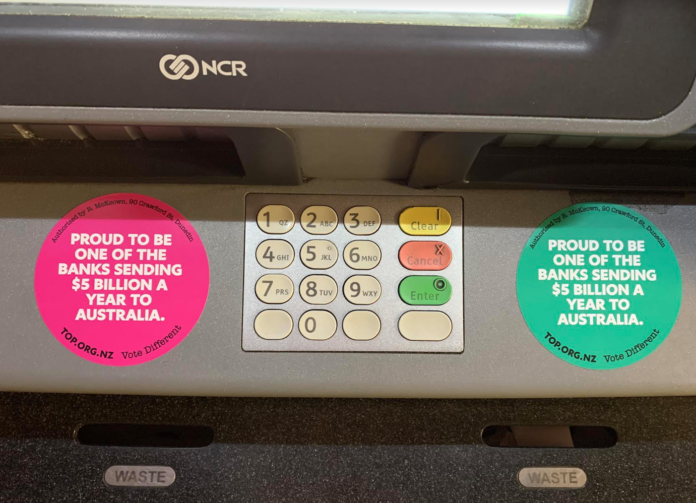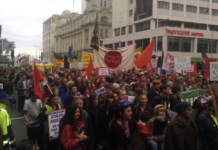Over the weekend TOP volunteers began a guerilla campaign against New Zealand’s Australian-owned banks, stickering hundreds of ATMs in our main centres.
And why not? Currently New Zealand is their ATM. We are one of the most profitable banking markets in the world.
TOP is calling for a Royal Commission into New Zealand’s banking, finance, and insurance industries. The one in Australia earlier this year unearthed all sorts of dodgy dealings. New problems are still coming to light, as we have seen with the money laundering scandal that led to the axing of Westpac’s Chief Executive. Remember this is the parent company of our government’s bank!
The Australian Royal Commission found problems in all the parent companies of our big four banks, so what makes us think we are immune from being ripped off? There are plenty of reasons to worry. The big four Aussie banks suck $5b out of our pockets annually. That is $14m a day. Roughly that means 20-25 cents of every dollar you pay in interest on your credit card or mortgage is going straight into their pockets.
To make matters worse, our banks don’t pay GST. That’s right, charging for financial services was deemed too difficult back when GST was created. But times have changed. Some countries have Financial Activities Taxes that simulate a GST. We should look at this too.
If that isn’t enough to convince you, here is a quick list of the problems already unearthed here in NZ. There is enough smoke here to be reasonably certain there is fire:
- Hisco’s dodgy expenses and house sale
- ANZ’s wonky capital buffers
- BNZ’s anti money laundering breaches
- Selling shonky interest rate swaps to farmers
- Overcharging for fees
- Some of the highest insurance commissions in the world
- Overcharging for low equity mortgages
- Underpaying interest on savings accounts
- Kiwi retailers paying twice the paywave fees
- Selling unnecessary insurance products
Do I need to go on? It is time to lift the rock that is the Aussie banks, and see what crawls out. After all as John Key likes to say if they have nothing to hide, they have nothing to fear.
The cost of living is too damned high, and something needs to be done about it. Housing is the chief cause of that, and the banks aren’t innocent on that count either. The second biggest driver of the high cost of living is getting ripped off at the hands of our big cartels.
National likes to whinge about the cost of living under this Government but has done a grand total of stuff all about either of these issues. Meanwhile Labour tinkers at the edges, promising transformational change but not wanting to scare the horses. Well, these horses need scaring. Just like we can’t afford our business cartels, Kiwis can’t afford another three years of the red and blue cartel.
TOP is the only party prepared to make fundamental change.
Geoff Simmons is the leader of TOP






Good on TOP for taking on this issue.
We used to have Labour and Greens on this sort of thing, but they are currently missing in action and propping up the construction industry which also helps the banks a lot!
They actually found in the UK that private partnerships with industry increased the costs dramatically and the biggest winners were actually the financial industry like banks!
For roads:
This report: https://image.guim.co.uk/sys-files/Society/documents/2004/11/24/PFI.pdf
found that PPP “contracts are considerably more expensive than the cost of conventional procurement”, resulting in higher returns for the companies running the PPP’s compared to their industry peers.
While hard to compare because of the opaque nature of many contracts and large amounts of subcontracting out, it looked like the actual cost of capital of the PPP’s was 11% compared to Treasure borrowing of 4.5% i.e. 6.5% higher. This is supposed to represent the cost of risk transfer but in practice there was no risk transfer so it’s money for nothing.
“In conclusion, the road projects appear to be costing more than expected as reflected in net present costs that are higher than those identified by the Highways Agency (Haynes and Roden 1999), owing to rising traffic and contract changes. It is, however, impossible to know at this point whether or not VFM (value for money) has been or is indeed likely to be achieved because the expensive element of the service contract relates to maintenance that generally will not be required for many years.”
Overall, for both roads and hospitals they concluded there was no risk transfer and not value for money.
“The net result of all this is that while risk transfer is the central element in justifying VFM and thus PFI, our analysis shows that risk does not appear to have been transferred to the party best able to manage it. Indeed, rather than transferring risk to the private sector, in the case of roads DBFO has created additional costs and risks to the public agency, and to the public sector as a whole, through tax concessions that must increase costs to the taxpayer and/or reduce service provision. In the case of hospitals, PFI has generated extra costs to hospital users, both staff and patients, and to the Treasury through the leakage of the capital charge element in the NHS budget. In both roads and hospitals these costs and risks are neither transparent nor quantifiable. This means that it is impossible to demonstrate whether or not VFM has been, or indeed can be, achieved in these or any other projects.
While the Government’s case rests upon value for money, including the cost of transferring risk, our research suggests that PFI may lead to a loss of benefits in kind and a redistribution of income, from the public to the corporate sector. It has boosted the construction industry, many of whose PFI subsidiaries are now the most profitable parts of their enterprises, and led to a significant expansion of the facilities management sector. But the main beneficiaries are likely to be the financial institutions whose loans are effectively underwritten by the taxpayers, as evidenced by the renegotiation of the Royal Armouries PFI (NAO 2001a).”
Same happens with hospitals, increases the costs approx 30% with no benefits!
For hospitals:
headline statistic:
“UK PFI debt now stands at over £300bn for projects with an original capital cost of £55bn”
https://www.theguardian.com/commentisfree/2017/aug/30/pfi-britain-hospital-trust-debt-burden-tax
“Conservatively estimated, the trusts appear to be paying a risk premium of about 30% of the total construction costs, just to get the hospitals built on time and to budget, a sum that considerably exceeds the evidence about past cost overruns.”
West PAC will plea bargain it down to a tax payer deductible fine so everyone will pay.
PPP contracts are the biggest scam of all time, as not only is the cost of capital injected higher for the banks than government, they also want a return on “equity” of which they have none invested.
And all of this is justified as being due to the transfer of risk from the public to the private banks.
Which again is BS, as all those contracts explicitly exclude the banks from any risk which they cannot cover through insurance. And any insurance cost is passed on to the PPP.
Any government that awards a PPP contract should be held liable for collusion and corruption as there is no way a PPP can be economically justified unless risk is passed to the banks.
Which it never is.
I found my mother with a gun barrel at her face, ready to kill herself after the bnz manager in timaru foreclosed on a mortgage they invented to steal her farm to give to another. A swindle brokered on a 22% odd interest rate.
You’re getting close. You’re getting ever closer to an horrendous swindle.
I’m crying. I have to go…
Words are great but action is far more important.
If you make it into parliament Geoff will you do something about it !!!
Well if he doesn,t we will never know … so help him get there one way or another!
Comments are closed.